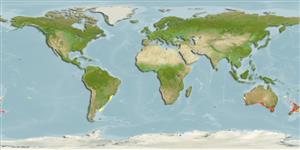Classificação / Names
Common names from other countries
Referência principal
Tamanho / Peso / Idade
Max length : 70.0 cm TL macho/indeterminado; (Ref. 9563); common length : 35.0 cm TL macho/indeterminado; (Ref. 3243); Peso máx. publicado: 2.9 kg (Ref. 6390); Idade máx. registada: 50 anos (Ref. 26998)
Length at first maturity
Lm ?, range 25 - 35 cm
Ambiente
; marinhas demersal; intervalo de profundidade 22 - 450 m (Ref. 58489), usually 100 - 250 m (Ref. 3243)
Clima / Intervalo
Subtropical, preferred 27°C (Ref. 107945); 27°S - 48°S, 62°W - 176°W
Distribuição
Indo-Pacific: St. Paul and Amsterdam islands in the Indian Ocean, southern Australia, including Tasmania, and New Zealand. Southwest Atlantic: southern South America.
Países | Áreas FAO | Ecossistemas | Ocorrências | Introduções
Descrição breve
Espinhos dorsais (total): 17 - 18; Raios dorsais moles (total): 25-28; Espinhos anais 3; Raios anais moles: 14 - 15; Vértebras: 35. Adults have elongate upper pectoral-fin rays and are silvery with a broad black band from the nape to the pectoral-fin base (Ref. 33616).
Categoria na Lista Vermelha da IUCN (Ref. 115185)
Ameaça para o homem
Harmless
Utilização humana
Pescarias: espécies comerciais; peixe desportivo: sim
Mais informação
ReferênciasAquaculturaPerfil para aquaculturaEstirpesGenéticaFrequência dos alelosHereditariedadeDoençasProcessamentoMass conversion
ColaboradoresFotografiasStamps, CoinsSonsCiguateraVelocidadeTipo de nataçãoÁrea branquialOutras referênciasCérebrosVisão
Ferramentas
Relatórios especiais
Descarregue XML
Fontes da internet
Estimates of some properties based on models
Phylogenetic diversity index
PD50 = 0.5078 many relatives (e.g. carps) 0.5 - 2.0 few relatives (e.g. lungfishes)
Nível Trófico
3.4 ±0.42 se; Based on food items.
Resiliência
Baixo, tempo mínimo de duplicação da população 4,5 - 14 anos (K=0.1-0.28; tm=3-6; Fec=100,000; tmax=50)
Vulnerabilidade
Moderate to high vulnerability (50 of 100)
Categoria de preço
